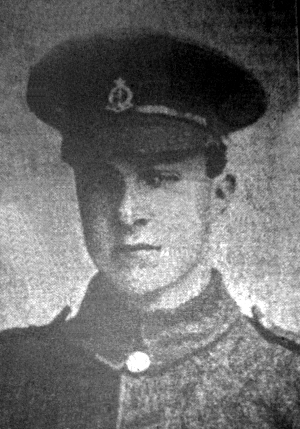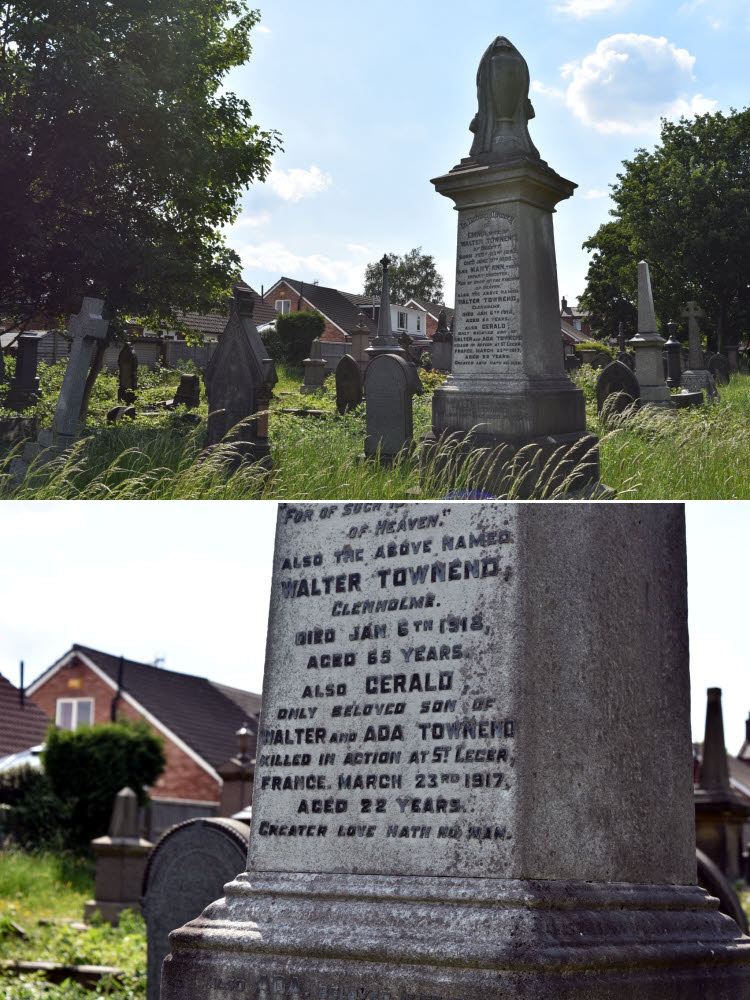
Gerald Townend was born in Ossett in 1894, the eldest child, and only son of Ossett mungo manufacturer Walter Townend and his wife, Ada (nee Oates), who married in early 1893. The couple had three children, all born in Ossett between 1895 and 1899.
In 1901, the Townend family were not at home and were on holiday in a Southport boarding house. In 1911, they were living in the spacious ten-roomed place called ‘Glenholme’, which was also known as ‘The Bungalow’, Runtlings, Ossett. Gerald by now was a mill worker, probably at his father’s mungo mill. Walter Townend died in early 1918.
Gerald Townend’s army service record has not survived, but it is known that he enlisted in Leeds, and he embarked for France on 1st May 1915, thereby qualifying for the 1914/15 Star in addition to the British and Victory medals.
The Field Ambulance was a mobile front line medical unit (it was not a vehicle). Most came under command of a Division, and had special responsibility for the care of casualties of one of the Brigades in the Division. Each Division had three Field Ambulances. The theoretical capacity of the Field Ambulance was 150 casualties, but in battle many would simply be overwhelmed by numbers. The Ambulance was responsible for establishing and operating a number of points along the casualty evacuation chain, from the Bearer Relay Posts which were up to 600 yards behind the Regimental Aid Posts, through the Advanced Dressing Station (ADS), to the Main Dressing Station (MDS). It also provided a Walking Wounded Collecting Station, as well as various rest areas and local sick rooms. The Ambulances would usually establish 1 ADS per Brigade, and 1 MDS for the Division.
22nd Field Ambulance, Royal Army Medical Corps joined 7th Division in late September 1914, as regular army units concentrated in the New Forest, Hampshire. The Division landed at Zeebrugge in the first week of October 1914, to assist in the defence of Antwerp, they arrived too late prevent the fall of the city and took up defensive positions at important bridges and junctions to aid in the retreat of the Belgian army. The 7th Division then became the first British Troops to entrench in front of Ypres, suffering extremely heavy losses in the The First Battle of Ypres. By February 1915 the Division had been reinforced to fighting strength and they were in action at The Battle of Neuve Chapelle, The Battle of Aubers, The Battle of Festubert, The second action of Givenchy and The Battle of Loos. In 1916 They were in action during the Battles of the Somme, including the capture Mametz, The Battle of Bazentin, the attacks on High Wood, The Battle of Delville Wood, The Battle of Guillemont and the Operations on the Ancre. In 1917 They fought during The German retreat to the Hindenburg Line and the flanking operations round Bullecourt during The Arras Offensive, before moving to Flanders for the Third Battle of Ypres, seeing action in The Battle of Polygon Wood, The Battle of Broodseinde, The Battle of Poelcapelle and The Second Battle of Passchendaele.
Private Gerald Townend was killed during the The German retreat to the Hindenburg Line between the 14 March to the 5th April 1917, which the 22nd Field Ambulance as part of 7th Division in Gough’s 5th Army were involved. The 7th Division was in the vicinity of Croisilles in late March 1917 and captured the village on the 2nd April.
In March 1917, the German armies on the Somme carried out a strategic withdrawal known as Operation Alberich. They destroyed everything on the ground that they left: flattening villages, poisoning wells, cutting down trees, blowing craters on roads and crossroads, booby-trapping ruins and dugouts. The withdrawal was to an immensely powerful and shorter line, positioned to take every tactical advantage of ground. The construction of this line – or rather, series of lines – had been spotted by British and French aviators in late 1916. British patrols began to detect the withdrawal of German infantry from the Somme in mid February 1917 and a cautious pursuit began, halted only as the Hindenburg Line itself was approached.
The “Ossett Observer”, 2 had this obituary for Private Gerald Townend:
“Son Of Ossett Ex-Mayor Killed – His Comrades’ Warm Tribute – The war continues to take its toll of local victims. This week’s list of local casualties includes the name of Private Gerald Townend (22), the only son of Mr. Walter Townend, mungo manufacturer, of Glenholme, Ossett, a former mayor of the borough.
An old scholar of the Dewsbury Wheelwright Grammar School, Private Townend enlisted within about a couple of months of the outbreak of the war, being engaged in learning his father’s business at the time. After a course of six months’ training, Private Townend proceeded to the Western front, and as a stretcher bearer was present at some of the early battles, including Loos, Hulloch, Festubert and Neuve-Chapelle, so that his experience of warfare was considerable. Only once, fourteen months ago, has he been on leave from the front.
The news of his death was conveyed in a letter from his commanding officer who wrote:
‘It is with deep regret that I have to inform you that your son Private G. Townend was killed in action about six a.m. this morning (March 23rd), He, with his his squad, was returning after carrying away a wounded officer, when a shell burst beside them, killing him and wounding another. I can assure you that he did not suffer at all, and his death was almost instantaneous. I am very sorry indeed to lose him. He was such a bright, merry boy, and very popular with all his comrades. You, with so many of your country’s people, must seek what comfort you can in the fact that your son died a gallant death, giving his life for his country, and just cause for which we are all striving.’
The regard in which the deceased was held by his comrades is evident from letters sent by them to his parents. One of his pals wrote:
‘We know what Gerald was to you at home, we know what he was to us out here. We knew his sterling value, and had learned the value of his cheerfulness, affection and good-heartedness. Gerald was a soldier, and a man, young as he was even: brave, courageous, helpful, unswerving in the course of duty, and ever and always ready to give a helping hand to his less fortunate comrades. He was one of the truest and most conscientious patriots I have ever met. I remember him coming out nearly two years ago. Since then there have been many tragedies in our unit, but none has created such a genuine feeling of sorrow as Gerald’s death, and on no occasion have I heard a more general expression of sympathy. He was, and always had been, an object of respect and admiration. He was one of the chief members of our family, and our loss is, in consequence, irreparable, and yours is immeasurably more so. But great as your sorrow is, prostrating as your grief may be, rest assured every member of our unit, from highest to lowest, mourns with you. He was cheerfully executing his duty when he met with his death, from the bursting of a shell. His death was instantaneous. He died the death of a hero, and though gone from us in body we shall always cherish the memory of him. His burial was simple, but full of pathos, and just the sort of burial a man of his character would desire. His grave shall have our respect and affection. On his cross are the word ‘Faithful under difficulties’. If it is possible, I will take a photograph of his grave and forward it on to you. I know you would treasure it.’
Another comrade in the course of his letter says:
‘Wherever Gerald went his presence was felt, the cheery optimism that overcame all difficulties, and whatever the the stress and strain, Gerald’s indomitable spirit overcame all, and made us feel less fatigued, able to laugh off our cares because he did, bale to carry on because inconspicuously Gerald’s stimulating influence was being felt. In the days that are to come, when we shall need all our strength to finish this titanic struggle, I pray that we shall have more of the spirit that Gerald infused into our lives while he was among us. Upon the cross that we raised above him today in a small graveyard within the sound but out of reach of shot and shell, under his name are the words ‘Gone ahead, but not forgotten. Beloved by all who knew him’. Thank God for his life, thank God for his splendid sacrifice, and may God help you to thank him for the privilege and honour of giving such a dear son for the cause which he undauntedly lived and died.”

Above: The Townend grave at St. John’s Methodist Chapel showing the memorial to Gerald Townend, the only son of Walter Townend. Picture courtesy of Lisa Jennings.
Private Gerald Townend, aged 22, the only son of the Mr. Walter Townend, of Ossett, was killed in action on the 23rd March 1917 and is buried at grave reference I. C. 1. at the London Cemetery, Neuville-Vitasse, 3 Pas de Calais, France. Neuville-Vitasse is a village in the department of the Pas-de-Calais, 5 kilometres south-east of Arras on the D5. London Cemetery stands on the west side of the road to Arras in a shallow valley.
Neuville-Vitasse was attacked by the 56th (London) Division on 7 April 1917 and captured by the same Division on 9 April. The village was almost entirely lost at the end of March 1918 but regained at the end of the following August. It was later “adopted” by the Metropolitan Borough of Paddington.
The London Cemetery was made by the 56th Division in April 1917 and greatly extended after the Armistice when graves were brought in from other burial grounds and from the battlefields between Arras, Vis-en-Artois and Croisilles.
London Cemetery contains 747 burials and commemorations of the First World War. 318 of the burials are unidentified and on a screen wall are panels bearing the names of casualties buried in the following four cemeteries, whose graves were destroyed by shell fire:-
Wancourt Road Cemetery No.2, just East of Nueville-Vitasse; Neuville-Vitasse Mill Cemetery, close to a German strong point on the road to Mercatel; Beaurains Road Cemetery No.2, just North-West of Nueville-Vitasse; Beaurains German Cemetery; and Erchin German Cemetery (Nord).
References:
1. The German Retreat to the Hindenburg Line
2. “Ossett Observer”, 31st March 1917